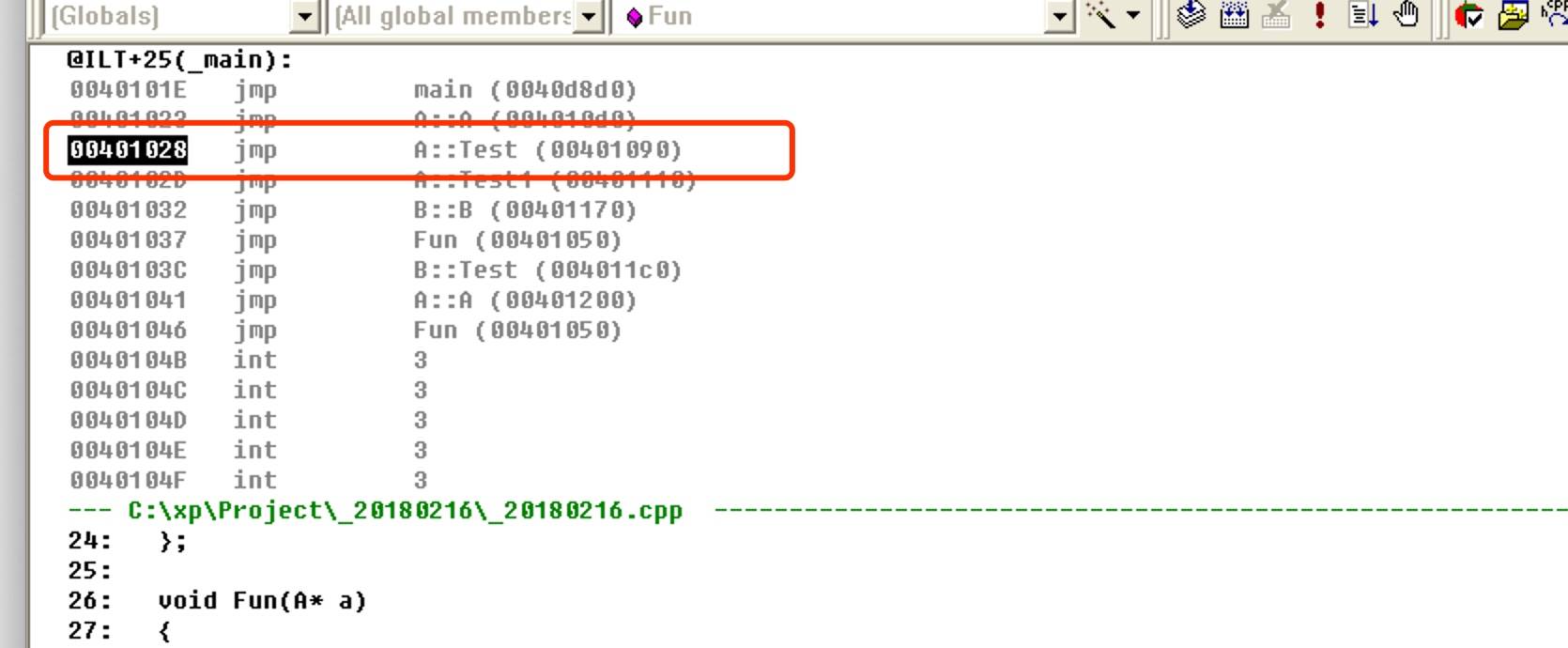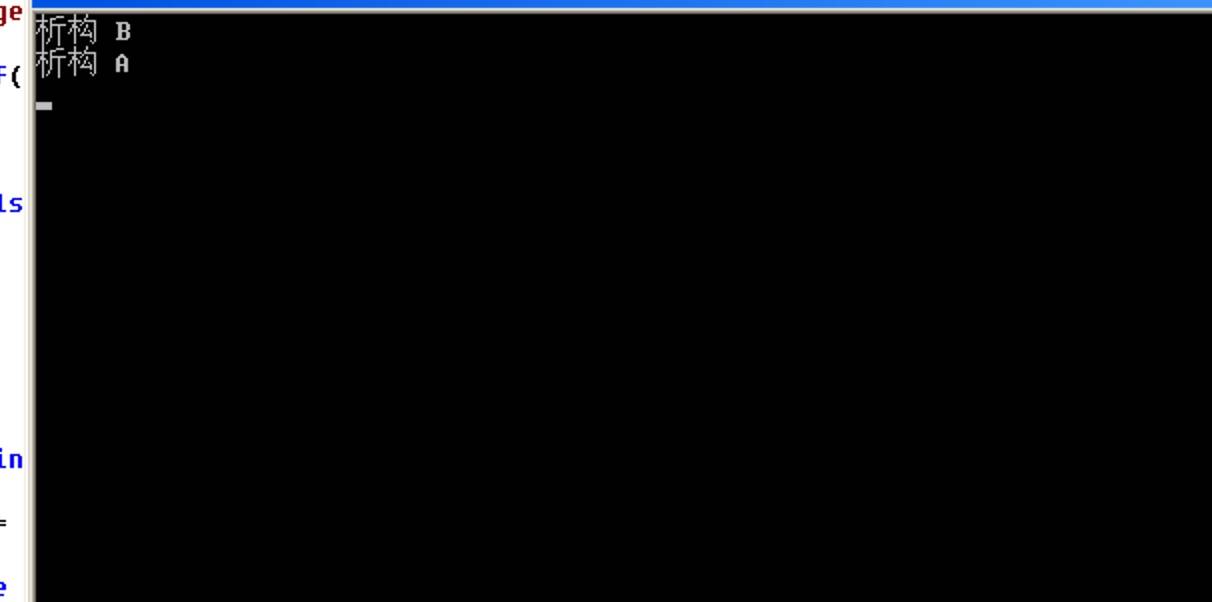Cpp7 C++的多态实现 — 虚表
多态的实现原理
#include "stdafx.h"
#include
#include
class A
{
public:
int x;
virtual void Test()
{
printf("A \n");
}
protected:
private:
};
class B:public A
{
public:
int x;
void Test()
{
printf("B \n");
}
protected:
private:
};
void Fun(A* p)
{
p->Test();
}
int main(int argc, char* argv[])
{
A a;
B b;
Fun(&b);
return 0;
}
//我们发现在这里 调用的test函数 是b的 因为fun方法传入的对象是b b继承自a 这里体现了多态
//反编译
31: void Fun(A* p)
32: {
00401050 push ebp
00401051 mov ebp,esp
00401053 sub esp,40h
00401056 push ebx
00401057 push esi
00401058 push edi
00401059 lea edi,[ebp-40h]
0040105C mov ecx,10h
00401061 mov eax,0CCCCCCCCh
00401066 rep stos dword ptr [edi]
33: p->Test();
00401068 mov eax,dword ptr [ebp+8]
0040106B mov edx,dword ptr [eax]
0040106D mov esi,esp
0040106F mov ecx,dword ptr [ebp+8]
00401072 call dword ptr [edx] //间接调用 + 虚表
00401074 cmp esi,esp
00401076 call __chkesp (00401240)
34: }
@ILT+0(?Fun@@YAXPAVA@@@Z):
00401005 jmp Fun (00401050)
@ILT+5(??0B@@QAE@XZ):
0040100A jmp B::B (00401190)
@ILT+10(??0A@@QAE@XZ):
0040100F jmp A::A (00401100)
@ILT+15(?Test@B@@UAEXXZ):
00401014 jmp B::Test (004011f0)
@ILT+20(?Test@A@@UAEXXZ):
00401019 jmp A::Test (00401140)
@ILT+25(_main):
0040101E jmp main (004010a0)
总结:
1. 当我们在类中定义虚函数时,就会产生虚表
2. 多态的实现 间接调用+虚表
虚表
观察带有虚函数的对象大小
#include "stdafx.h"
#include
#include
class A
{
public:
int x;
void Test()
{
printf("A \n");
}
protected:
private:
};
int main(int argc, char* argv[])
{
A a;
printf("%d \n",sizeof(a));
return 0;
}
//结果是4
#include "stdafx.h"
#include
#include
class A
{
public:
int x;
virtual void Test()
{
printf("A \n");
}
protected:
private:
};
int main(int argc, char* argv[])
{
A a;
printf("%d \n",sizeof(a));
return 0;
}
//结果是 8
#include "stdafx.h"
#include
#include
class A
{
public:
int x;
virtual void Test()
{
printf("A \n");
}
virtual void Test1()
{
printf("A \n");
}
protected:
private:
};
int main(int argc, char* argv[])
{
A a;
printf("%d \n",sizeof(a));
return 0;
}
//结果还是8
发现:定义了虚函数 对象大小会多出4个字节,多个虚函数也只有多一个4字节
虚表的位置
#include "stdafx.h"
#include
#include
class A
{
public:
int x;
virtual void Test()
{
printf("A \n");
}
};
class B:public A
{
public:
virtual void Test()
{
printf("B \n");
}
};
void Fun(A* a)
{
a->Test();
}
int main(int argc, char* argv[])
{
A a;
B b;
Fun(&a);
Fun(&b);
return 0;
}
通过vc6的监视器发现a对象的具体结构
发现加了虚函数之后对象前面对了一个值 指向 0x00422fac
那么这里的值指向的就是虚表的位置
继续追踪
调出内存窗口查找此内存
里面的值是 00401028 (小端存储)
vc6中 ctrl +g 跳转到对应反汇编位置
这里指向的正好是A的test 方法
(此时多了个TEST1 是因为上次编译后的结果没有清理缓存 )
26: void Fun(A* a)
27: {
00401050 push ebp
00401051 mov ebp,esp
00401053 sub esp,40h
00401056 push ebx
00401057 push esi
00401058 push edi
00401059 lea edi,[ebp-40h]
0040105C mov ecx,10h
00401061 mov eax,0CCCCCCCCh
00401066 rep stos dword ptr [edi]
28: a->Test();
//取参数也就是a对象的指针 到eax
00401068 mov eax,dword ptr [ebp+8]
//读取eax也就是a对象的首地址 也就是虚表的位置
0040106B mov edx,dword ptr [eax]
0040106D mov esi,esp
//传递this指针,到ecx
0040106F mov ecx,dword ptr [ebp+8]
//调用虚表中记录的函数位置 这里是第一个就直接是edx
00401072 call dword ptr [edx]
00401074 cmp esi,esp
00401076 call __chkesp (00401240)
29: }
//虚表
00401023 jmp A::A (004010d0)
00401028 jmp A::Test (00401090)
0040102D jmp A::Test1 (00401110)
00401032 jmp B::B (00401170)
00401037 jmp Fun (00401050)
0040103C jmp B::Test (004011c0)
00401041 jmp A::A (00401200)
虚表的结构
据观察,虚表中存储的都是函数地址,每个地址占用4个字节,有几个虚函数,则就有几个地址
虚表的内容
子类没有重写时的值
#include "stdafx.h"
#include
#include
class A
{
public:
int x;
virtual void Test()
{
printf("A \n");
}
};
class B:public A
{
public:
};
void Fun(A* a)
{
a->Test();
}
int main(int argc, char* argv[])
{
B b;
Fun(&b);
return 0;
}
//虚表
00401014 jmp A::Test (00401140)
子类重写时的值
#include "stdafx.h"
#include
#include
class A
{
public:
int x;
virtual void Test()
{
printf("A \n");
}
};
class B:public A
{
public:
virtual void Test()
{
printf("B \n");
}
};
void Fun(A* a)
{
a->Test();
}
int main(int argc, char* argv[])
{
B b;
Fun(&b);
return 0;
}
//虚表
@ILT+15(?Test@B@@UAEXXZ):
00401014 jmp B::Test (00401150)
@ILT+20(?Test@A@@UAEXXZ):
00401019 jmp A::Test (004011e0)
析构函数问题
class A
{
private:
int* a;
public:
A()
{
a = new int[10];
}
~A()
{
delete a;
}
int* get_a()
{
return a;
}
}
class B:public A
{
private:
int* b;
public:
B()
{
b = new int[5];
}
~B()
{
delete b;
}
int* get_arr(int flag)
{
if(flag == 1 )
{
return b;
}
else
{
return get_a();
}
}
}
int main()
{
A* p = new B;
delete p;
return 0;
}
上述代码执行时,如果直接调用 指针类型是父类,那么只会执行父类的析构函数释放掉 int* a
而b类中的int* b却不会被释放掉
理论上最好的方式是 逐步往上调用所有的析构函数,这样才可以释放所有使用的内存
// _20180212.cpp : Defines the entry point for the console application.
//
#include "stdafx.h"
#include
#include
class A
{
private:
int* a;
public:
A()
{
a = new int[10];
}
virtual ~A()
{
delete a;
printf("析构 A \n");
}
int* get_a()
{
return a;
}
};
class B:public A
{
private:
int* b;
public:
B()
{
b = new int[5];
}
~B()
{
delete b;
printf("析构 B \n");
}
int* get_arr(int flag)
{
if(flag == 1 )
{
return b;
}
else
{
return get_a();
}
}
};
int main(int argc,char* argv[])
{
A* p = new B;
delete p;
return 0;
}
这里 将父类的析构函数定义为虚函数,那么delete的时候 就会调用子类重写父类虚析构函数的析构函数(虽然名字不相同,但是会自动重写_编译器约定)
并且此时析构函数现实从下往上逐步执行



